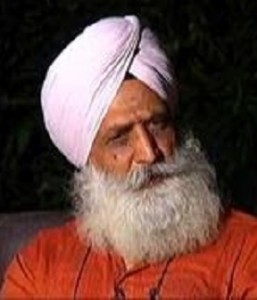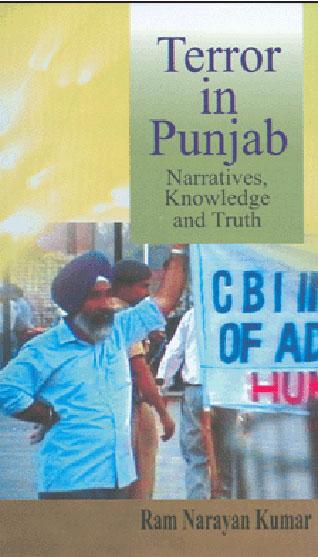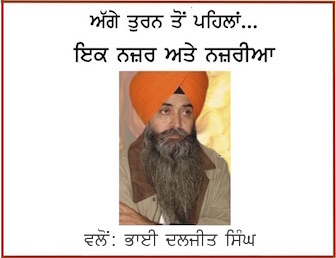Articles/Opinion » Selected Articles » Sikh News
‘True History could help Sikhs knowing their present placing and future in India’
September 2, 2014 | By Jaspal Singh Sidhu
Review of the book “Terror in Punjab – Narrative, Knowledge and Truth” (author: Ram Narayan Kumar) by S. Jaspal Singh Sidhu

Jaspal Singh Sidhu
Former Defense Minister of Japan aptly said: ‘History is too important to be left to newspaper editors’. The media, invariably, glosses over what actually happened on the ground and help the rulers in gradual blunting of the horrible edges of colossal human tragedy and atrocities into something ‘banal’—means a trivial and uninterested matter for the common man. Should the victims be made to forget ‘how they were demonized to justify the state repression on them’?
And, a sociologist commenting on ‘Politics from November 1984 to Gujarat 2002 pogroms of Sikh and Muslims’ says : “Evil becomes banal (uninterested being very common) when it acquires an unthinking and systematic character. Evil becomes banal when ordinary people participate in it, build a distance from it and justify it in countless ways. There are no moral conundrums or revulsion. Evil does not even look like evil, it becomes faceless”.

Terror in Punjab – Narratives, Knowledge and Truth (book by Ram Narayan Kumar)
For better understanding of such process of banalisation ,the Sikhs should know the recent history to enable them to assessing their present placing and future probabilities in India. Historical studies, however, could be a part of disinformation project for its being a sponsored one or an outpouring of a jaundiced mind (Left historians’ nationalistic perspective tend to overlook repression on the Sikhs)’. The suggestion of eminent historiographer E.H.Carr is worth remembering that one must know credentials and background of the author before reading his/her book. In this context, late Ram Narayan Kumar stands apart and so his book “Terror in Punjab—Narrative, Knowledge and Truth” published in 2009 by Shipra Publications, Delhi.
Kumar right from his adolescent years had plunged in grass-root work, public campaigns and defiance of the authority which saw him jailed and tortured during Emergency and put him on path of life-long struggle for human rights. He was found dead at the age of 53 at his Kathmandu flat in 2009. Kumar got interested in the Sikh affairs when he was helping the Sikh victims of November Sikh pogrom in Delhi. Later, he devoted 19 years in Punjab for getting justice for the victimized Sikhs and in documenting the state atrocities on the minority. During that period, he studied the Sikh history, culture and religion and produced four books of an academic excellence.
A few points from his analysis of ‘the Sikh affairs vis-a-vis Indian state’ are being reproduced in this article as a tribute to Kumar, a non-Sikh and an outsider to Punjab whose painstaking study vividly exposes the New Delhi’s ‘machination’ in Punjab.
I focus on what ‘What is Sikh Dissent?’, a lengthy chapter in his book says:
“ The Sikh dissent is essentially grounded in an emotive rejection of India’s historical blunders that have reduced the promise of ‘swaraj’ (self-rule) and struggles of the people in the Indian sub-continent against the British imperialism to the deception and the negation of the promised it has become in the post-colonial period. The Sikh dissent is the negation of this negation and it has, as a project of recovering the denied, failed.”
Who is a Sikh and what constitutes the uniqueness of a Sikh IDENTITY? The Sikh a disciple and learner, of ten Gurus, personified by the Guru Granth, (scripture) as recited and revered by the community of initiated Sikhs or ‘Khalsa’ , is neither a HINDU nor a MUSALMAN. The answer is primordial to the Sikh religious traditions. In 1499, Guru Nanak disappeared and reemerged from the river in Punjab and believed to have pronounced—“There is no Hindu, there is no Musalman”. Guru Nanak called for abandoning of denominational identifications of Hindu and Muslims as they spring delusions. His God, as ultimate truth of existence both in creative and transcendental aspects, was free from anthropomorphic attributes. Religious practice Nanak reduced to three simple commandments—Kirt karo, nam japo, vand chhako—work hard, remember God through the Name, and practice sharing.
Renouncing of the Hindus rituals as wearing ‘jenaeu’ (sacred thread) by Guru Nanak and later, attaching of ‘guru ka langar’ (common -community kitchen) to the Sikh centers of worship (gurdwaras) and incorporating of hymns of Muslim and Indian mystics born as untouchables in the scripture, being worshiped as ‘living Guru’, were the main reasons why the orthodox Hindus became prejudiced against the new religion from the very beginning. And, there had been strong attempts by the Hindu elements in Punjab to obfuscate the Sikhs’ uniqueness and distinctiveness.
The British interests in resurrecting “the glory that was Hindu India” was connected with their requirement to justify the destruction of the Moghal India. The British government commissioned study of Guru Granth Sahib by German Indologist Ernest Trumpp suggested “Sikhism was a kind of pantheism and degenerated Hinduism” which became the basis of the Arya Samaj’ campaign of ‘vilification against the Sikh religion in Punjab’. Singh Sabha movement awoke to the challenge of the Arya Samaj, particularly to the latter’s ‘suddhi’ (purification) campaign aimed at reconverting the poor untouchable Sikhs back to the Hindu fold.
As consequent to tensions in Hindu-Sikh relation, after exactly 400 years after Guru Nanak’s first statement Bhai Kahn Singh Nabha, a scholar of Sikh religious resurgence considered it necessary in 1899 to write out a long tract to categorically clarify that ‘ Hum Hindu Nahin’—we (Sikhs) are not Hindus.
The rise of Hindu nationalism in the first quarter of 20th century saw worsening of the Hindu-Sikh tensions. The Sikh reformers prevailed upon the manger of the Golden Temple to remove all Hindu idols from temple precincts in 1905. Udasi abbots ( Udasi is Hindu sect) who were siding with new maters, the British, had also restricted the entry of untouchables in the Golden Temple during their decades long control. The ‘gurdwara reform movement became visibly strong in 1919 got freed the Sikh shrines from Udasi abbots and formed SGPC in November 1920.
The Sikh leaders were shocked when the Congress leaders, including Gandhi, became hostile as soon as they were able to obtain official recognition of their DISTINCT RELIGIOUS STATUS. Nehru wrote to a friend in April 1924 “Their (the Sikhs) movement is largely a SEPARATIST MOVEMENT, as far as religion concerned, and this has naturally reacted in the social and political sphere”.
Soon Gandhi began writing letters to the Sikh leaders, questioning their claim of DISTINCTION, “ I personally do not see any difference between the Sikhism and Hinduism…..It is wrong to make difference between the Hindus and the Sikhs….. The Guru Granth Sahib is full of the teachings of the Vedas. Hinduism is like a mighty ocean, which receives and absorbs all religious truths” (after a century later– present RSS chief Mohan Bhagwat makes a similar statement towards the end of August 2014)
Urban Hindus in Punjab organized on the platform of Hindu Mahasabha in 1926 and opposed the ‘Relief of Indebtedness Bill’ of 1940 which was introduced to free the farmers (rural peasants) from swelling indebtedness which had made them lose away their cultivable lands.
The Hindu Mahashaba which was having Lala Lajpat Rai as its top leader, merged in Congress in December 1936 to oppose communal award giving weight-age to Muslim and Sikh minorities in the shape of ‘separate electorates’. Thus, the Congress party in Punjab absorbed the Hindu parochialism and communal stringency, which had previously given sap to the Arya Samaj.
Devolution of political power from the Center to the provincial governments was the guiding principles of India’s democratic progress under the British Empire and Cabinet Mission of 1946 had brought a ‘confederation sort of vision’ for free India. The Congress leaders led by Nehru and Patel had acquired a grip over the Sikh politicians. They instructed the Sikh politicians in rejecting the Mission to emasculate the Muslim Federation as suggested by the Mission. Congress leaders also made Akali leaders -Master Tara Singh and Baldev Singh– to raise the demand of ‘Sikh Home Land’ ( a version of now-a-days ‘Khalistan’) to counter Jinnah’s Muslim League’s demand for Pakistan. Congress leaders offered Defense Ministry to Baldev Singh (an elevation for him from his being a minister in Punjab) in the Interim Government in 1946 “on the condition that he would keep the Sikhs rolling on the tacks of Hindu India”. The heavyweight British officers—Pendral Moon and Major Short—known as ‘friends of Punjab’- attempted to persuade the Sikh leaders to break out the Congress stranglehold and explore keeping the unity of Punjab by negotiating terms with the Muslim League. They secretly arranged talks with the Muslim League leaders. But Congress leaders found out and got Baldev Singh to disrupt the negotiations. The Sikhs were the biggest losers of the Partition as they suffered huge casualties besides losing large tracts of fertile land in canal colonies and got in lieu in east Punjab an undeveloped and lesser acreage of land as compared to what they left in west Punjab. The Sikhs lost Guru Nanak’s birth place, Nanakana Sahib and other historical Sikh shrines located across the border in Pakistan.
The Sikh leaders were coaxed to accept the Partition (by Congress leaders) on the basis of promise that the “Congress will help them to arrange east Punjab that it may become the CULTURAL HOME to the Sikhs…. as one Sikh leader informed Pendral Moon in June 1947”.
After one year, the same Sikh leaders approached Mountbatten (first Governor General of free India) in 1948 to beseech him to prevail upon Nehru and Patel to keep their pledges with the Sikhs. Mountbatten himself was full f foreboding on the future of the Sikhs and penned down in February 1948: “The Sikhs as part of Pakistan would have retained a measure of political identity. But as part of Hindustan, they feared economic absorption by the Hindus; also religious absorption. In short, they feared, probably correctly, virtual extinction as a political force and survival only a rapidly dwindling religious sect of Hinduism”.
Master Tara Singh, spearheading the Akali agitation for Punjabi speaking state was the first politician to be arrested under a preventive law in free India. During the 19-year- long period of the Sikh agitation for a Punjabi suba saw denial of mother tongue by a section of Hindu Punjabis and main opposition came from the Congress party and leaders of Arya Samaj with Lala Jagat Narain heading the ‘Maha Punjab Samiti’. Prime Minister Lal Bahadur Shastri conceded Punjabi suba after he had reached an unofficial deal with the Akali leaders that their demand would granted if they help India (on the brink of a war with Pakistan in 1965) in crushing the threat from across the border. Even new Punjab state created in 1966 was denied the due share in river waters, Chandigarh capital and a large expanse of Punjabi speaking areas.
Lala Jagat Narian was the star speakers at a Nirankari convention in Amrtisar when seventeen Sikhs marching towards convention were killed in firing (from within the Nirankari camp). And, the Amritsar happening became the cause of fresh troubles in Punjab.
Over the period, the Center concentrated economic and political powers in New Delhi. Between 1970-1974, nineteen state governments were subverted (toppled), Emergency was clamped in 1975 and Tamil Nadu government was toppled for not implementing the central directive of censuring the press and to jail the anti-Emergency activists.
The critical thinking against such centralization of powers in New Delhi permeates the Anandpur Sahib Resolution drafted by the Akalis and which sought constitutional re-look on center-state relations. Later, the Resolution became the basis of the Akali Dal agitation began in August 1982. Around three lakh Akali workers courted arrest as part of their peaceful ‘satyagraha’ which Gandhi was used to undertake during freedom struggle. Since the Sikh have been harboring an anxiety for maintaining their identity, the Akalis also included in its 45- point charter some religious demands like granting of holy status to Amritsar on the pattern of Hardwar, Kashi and Kurukshetra, relaying of kirtan from Golden Temple on AIR and permission to the Sikhs to wear ‘kirpan on domestic and international flights and enactment of All India Gurdwara Act.
It was the year, 1984, when “the Big Brother (New Delhi establishment) threw away the shibboleth of constitutional democracy and embarked on the path of transformation from the secular democratic state into majoritarian tyranny with strong fascist tendencies to deal with smallest religious minority (the Sikhs). I am referring to politics behind the military attack on the Golden Temple of Amritsar, the Sikh Vatican, in June 1984 and again the organized massacre of Sikhs in Delhi and other places following assassination of Prime Minister Indira Gandhi on 31 October 1984.”
Indian Establishment portrayed the Sikh struggle as “Pakistan inspired crusade for Khalistan, an independent Sikh State aiming primarily to hurt and enfeeble India”. And it “let loose the reign of terror on the Sikhs and denied them even negotiated settlement what New Delhi has been having while dealing with open champion of secession like the armed Naga groups in the northeast”.
“Not a single demand of the Akali Dal charter has been met. The state repression has not only cost several thousand lives but has also successfully eclipsed perceptions of the vanquished (the Sikhs) and the truth what really happened under the hegemonic narratives of the Punjab turmoil. Post-colonial history of India has ended with successful decimation of the Sikh dissent. The Akalis (the Badals) , back in business of politics with all the regular fluctuations of fortune within MAJORITARIAN FRAMEWORK of democracy in India, have become (sensibly) silent on the issues of Sikh dissent that precipitated one of the most brutal and sustained repressions of a numerically insignificant minority by the any government in the world.”
“The slogan of Khalistan which has never been raised by the Sikhs of Punjab and has never done good to anyone other than their enemies is again in the air.”
* Author, Jaspal Singh Sidhu, is a senior journalist. He may be reached at: jaspal (dot) sdh (at) gmail (dot) com
To Get Sikh Siyasat News Alerts via WhatsApp:
(1) Save Our WhatsApp Number 0091-855-606-7689 to your phone contacts; and
(2) Send us Your Name via WhatsApp. Click Here to Send WhatsApp Message Now.
Sikh Siyasat is on Telegram Now. Subscribe to our Telegram Channel
Related Topics: Jaspal Singh Sidhu, Khalistan, Ram Narayan Kumar




